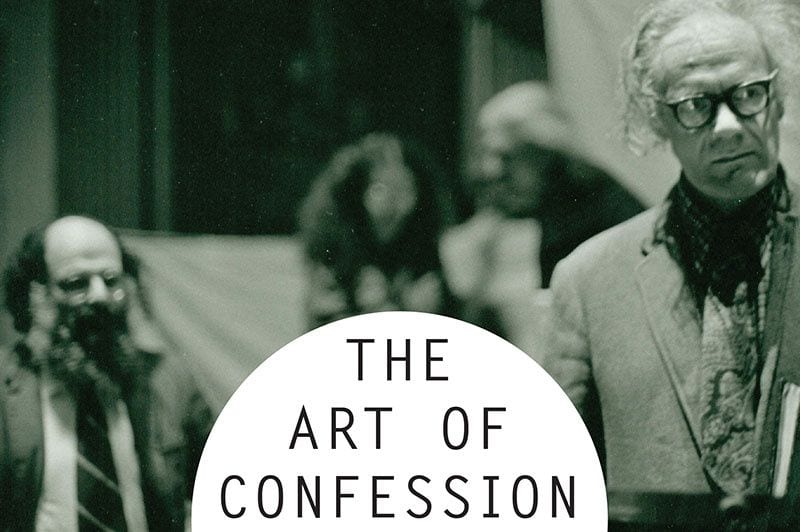Tracing a thread from Robert Lowell to reality TV seems like an ominous task, and it is one that Christopher Grobe tackles by laying out several intertwining threads. The history of an idea, like confession, is only linear when we want to create a sensible structure, the “one damn thing after the next” that is the standing critique of creating historical accounts. The organization Grobe employs helps sensemaking.
On the academic side, performance studies has some origins in the oral interpretation of literature practiced in English and speech communication departments. Grobe ties the tradition of oral interp to Sylvia Plath, the poet who, in many contemporary circles, is deemed emblematic of confessional poetry. Grobe gives agency to the work itself: “But what a confessional poem is, even while sitting on the page, is inseparable from what it wants to do — to the poet and to the public.” Readers who analyzed literature under the banner of New Criticism, taught to believe in proclamations of the death of the author, may struggle to reconcile these arguments. But if we place ourselves at the poetry reading, it’s easier to see confessional poetry as an embodied, performative practice.
Along with the development of oral interpretation in the classroom, Grobe brings us Allen Ginsberg in the coffeehouse, and later the recording studio, chanting the Holy! Holy! of Howl. These performances of confessional poetry, Grobe argues, can be almost embarrassing — not for the poet but for the audience, trying to balance the intimacy of the poem and the social distance of the poet. This seems to be a compelling question of the performance of confession: do we really want to know all of this about this person? The mediated distance of reality TV alleviates the dilemma, because it’s far more comfortable to be a spectator of electronic intimacy. Curiously, that distance also give the audience plenty of room to judge.
Marking 1959 as the pivotal year when J.L. Austin was writing How to Do Things with Words and the spread of method acting, Grobe describes how the idea of performativity begins to take shape. Not to say that it was easily defined, or that it went uncriticized. Performativity is a sticky term, and trying to piece it apart while also recognizing all the ways that it clings to certain words, artforms, and actions is central to Grobe’s project. Robert Lowell’s Life Studies — an urtext of confessional poetry — and Erving Goffman’s The Presentation of Self in Everyday Life were both published in this heightened moment of awareness about performance and performativity.
Grobe also brings Anne Sexton into this discussion. Where Goffman assures us that the performance of self is always already true because the self can be contradictory and complicated, Sexton twists truth and fabrication into a baffling series of knots. In her poems, her performance, and her correspondence, anything can be true or false. If the confessor creates the veil of artifice, should her confessions be taken seriously? Or is the puzzling bunch of knots more of an engaging pleasure than the flat-out confession? In the interlude that follows his case study of Sexton, Grobe reminds us that in 1959, Betty Friedan had a breakthrough in her research for The Feminine Mystique; she attended a kind of proto-consciousness-raising session that gave her the famous phrase “the problem that has no name”. He skillfully does not belabor the point of this coincidence but rather uses it to segue into a discussion of women’s performance art that is both confession and performance of self, perhaps finding its origins in consciousness raising within the women’s liberation movement.
Grobe’s occasional first-person appearances affect a bond of discovery between reader and author. The book is enhanced by a feeling that Grobe is working to piece things together, and take them apart, to present them to the reader for further contemplation. A poignant case is found in his discussion of finding audiotapes of Eleanor Antin’s performance of Eleanor of 1954 after considerable study without access to the performance itself. In this discussion, Grobe assembles a performance of researcher that resonates strongly throughout the book. Seeing the author arrive at his conclusions, rather than present them as a fait accompli, offers a compelling act of reading. Author-as-confidant becomes a kindly companion, one much needed when reading the analysis of Spalding Gray’s performances, knowing that we are huddling together under the dark umbrella of Gray’s eventual suicide.
Grobe begins the last case study, “Broadcast Yourself” by noting, “Perhaps the most confessional thing about reality TV is that we aren’t allowed to say that we watch it — we must confess.” He goes on to argue that performance is not a put-on but an actualization of self, and that the notion of performativity that he embraces has seldom been used in reference to reality TV. He becomes somewhat dismayed, and rightly so, that reality TV scholars have routinely ignored performances of poetry and performance art as precedents for the confessional feature of reality programming. The chapter shows the solid connections that have previously being neglected.
The case studies hold together not only because Grobe crafts them as a coherent history but also because they come full circle, for example, when Spalding Gray imagines himself as Robert Lowell. That Gray’s performance of monologue as both/and — writer, poet, actor, director, performance artist – -also echoes Lowell’s blurring of the lines between poet and performer. The case studies could have been expanded to be books themselves because they are deep, engaged studies, but tying them together creates a more satisfying book and a way for readers to understand how performance and confession got from there to here.

